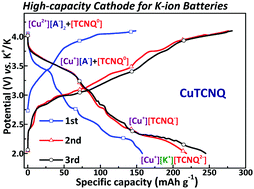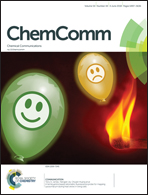Endowing CuTCNQ with a new role: a high-capacity cathode for K-ion batteries†
Abstract
Herein, copper-tetracyanoquinodimethane (CuTCNQ) with phase-I kinetics character has been proposed as an effective cathode for potassium-ion batteries. In a voltage range of 2–4.1 V (vs. K+/K), both cuprous cations (Cu+) and organic anions (TCNQ−) are electrochemically active, and they render a three-electron redox mechanism, thereby enabling CuTCNQ to yield a high specific discharge capacity of 244 mA h g−1. Even after 50 cycles, the discharge capacity of 170 mA h g−1 is retained at 50 mA g−1. In addition, when the current density is elevated to 1000 mA g−1, the discharge capacity is still maintained at 125 mA h g−1. These test data are among the best results reported for high-potential cathodes of potassium-ion batteries.



 Please wait while we load your content...
Please wait while we load your content...